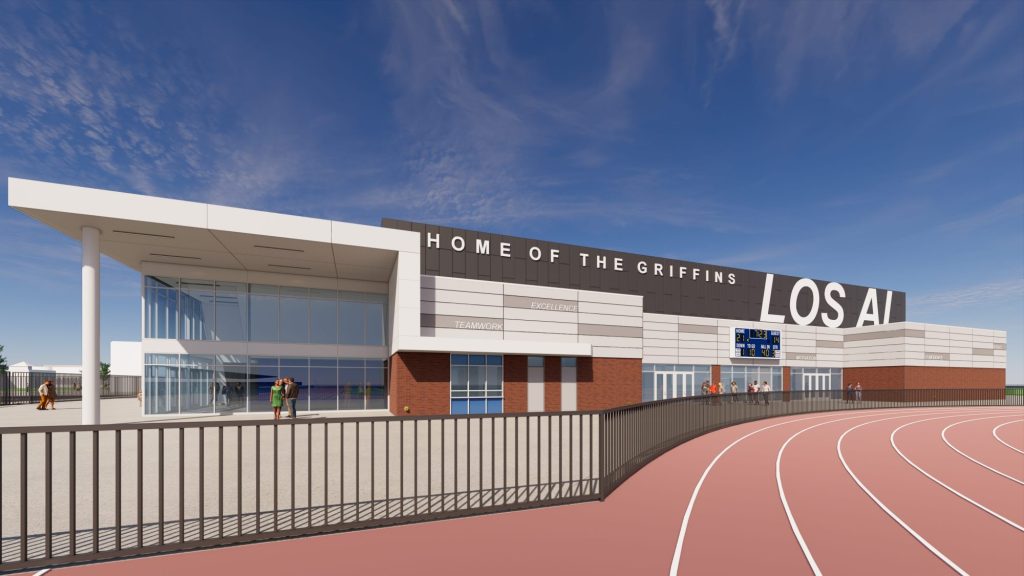Athletic programs do more than build strong bodies — they shape confident, resilient individuals. School districts continue to invest in new athletic facilities, and it’s critical to consider how the built environment can support not just physical performance, but the mental health and emotional well-being of student-athletes.
WD believes athletic design should take a holistic approach. Drawing from our extensive work in healthcare and behavioral health, we know how environments can influence recovery, focus, social connection, and long-term wellness. When these insights are applied to K-12 athletic complexes, the result is a facility that empowers students to thrive — on and off the field.
The Mental Game: Why Design Matters
Athletes today are facing more pressure than ever. From academic expectations and competitive demands to the social dynamics of high school life, their mental wellness is a crucial factor in overall performance.
“Students should feel that their training environments are as supportive as they are challenging,” says Ken Ong, Director of Architectural Design at Westgroup Designs. “The spaces we create are not just for games and workouts — they’re places where young athletes reset, connect, and build confidence.”
Thoughtful programming and planning allow for spaces that encourage rest, mentorship, nourishment, and connection — all of which are foundational to mental health.
Design Strategies That Foster Wellbeing
1. Social spaces that build community
Athletics is often where lifelong friendships are formed. We prioritize spaces like team lounges, film rooms, and multi-use game rooms that foster camaraderie and inclusivity — not just for varsity starters, but for all students. In our upcoming gymnasium for Los Alamitos High School, the design features four team rooms and a film room — intentionally placed to encourage shared time before and after training sessions.

2. Spaces for recovery and rest
Just as athletes need to push their limits, they also need space to rest and recharge. Inspired by the calming, restorative environments we’ve created in behavioral health facilities, our athletic designs incorporate quieter zones and designated areas for reflection, stretching, or decompression. In Los Alamitos' gym, this includes dual outdoor plyometric spaces that serve as transitional zones between high-energy activity and restorative movement.
3. Nutrition-forward design
Our athletic spaces often feature concessions or nutrition stations that encourage healthy habits. And, when possible, we design adjacent spaces that accommodate chef demonstrations or educational nutrition programming — an approach we’ve borrowed from wellness facilities and brought into the student-athlete environment.
4. Visibility and mentorship
Where possible, we explore design opportunities that create visibility between youth programs, student-athletes, and coaching staff — reinforcing a shared culture of growth. Overlapping team rooms, transparent corridors, and shared training zones foster positive interaction and team spirit.
Turning Vision into Reality
Our work with school districts across California reflects this belief in holistic athletic design:
- Los Alamitos Unified School District – New Gymnasium
Currently in construction, a 34,000-sf, state-of-the-art, three-court facility with a 2,000-seat retractable bleacher system, outdoor training zones, team rooms, and film space is set to be completed in the Summer of 2025. - Fillmore High School – Varsity Baseball Field
This recently completed new athletic complex was designed to strengthen both performance and school pride. While initial bids exceeded the District’s budget, we remain committed to delivering a top-quality facility through a rebid process — proving that student wellbeing doesn’t have to come at the expense of budgetary goals. - Trabuco Hills High School – Stadium & Track Upgrades
Working with Saddleback Valley USD, we revitalized aging facilities with a new track system, synthetic turf, accessibility upgrades, and improved spectator experiences — because student-athletes deserve environments that meet their excellence.
Supporting the Whole Athlete Mental health is not a standalone conversation. It’s a layer woven into every decision — from daylighting and acoustics to circulation and the location of gathering spaces. By incorporating lessons learned from decades in healthcare and behavioral design, we’re elevating the standards of K-12 athletic environments.

